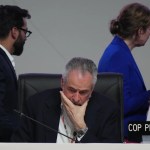US Secretary of State Marco Rubio insisted that the proposed 28-point plan to end the war in Ukraine, widely seen as favorable to Russia, was “authored by the US”.
It came after a group of senators said Rubio told them the draft – which he said he called Russia's “wish list” – did not reflect Washington's position.
Rubio later distanced himself from these claims and said the plan came from the US and was “based on input” from both Russia and Ukraine.
His intervention came as he was flying to Geneva in Switzerland for talks with Ukrainian and European security officials over the plan, which US President Donald Trump has urged Kyiv to agree to as soon as possible.
Ukraine's allies in Europe rejected the main provisions of the draft, which was not made public, but details of which were widely leaked online.
It includes Ukraine's agreement to withdraw troops from eastern regions that Russia has failed to seize by force and to limit the size of its armed forces.
Republican Sen. Mike Rounds said Saturday that Rubio told a group of lawmakers that the draft plan was not U.S. policy.
He told the Halifax Security Forum: “What [Rubio] we were told that this was not an American proposal.”
Rounds said he was assured that the plan was presented to Steve Witkoff, who acts as Trump's foreign diplomatic envoy, “by someone … representing Russia.” The senator continued: “This is not our recommendation. This is not our peace plan.”
Shortly afterward, State Department spokesman Tommy Pigott said Rounds' account of his conversation with Rubio was “patently false.”
He wrote on X: “As Secretary Rubio and the entire administration have consistently maintained, this plan was developed by the United States with the participation of both the Russians and the Ukrainians.”
Then Rubio himself wrote on social media: “The peace proposal was authored by the United States. It is based on the contribution of the Russian side. But it also builds on Ukraine’s previous and current contributions.”
On Saturday, Trump, who has made reaching an agreement to end the conflict a top foreign policy goal during his second term, said the plan did not represent a “final proposal” for Ukraine, having previously said President Volodymyr Zelensky would “have to” approve it.
In a post on X Saturday, Vice President J.D. Vance said criticism of the proposed peace plan “either misunderstands the framework or misrepresents some critical realities on the ground.”
“There is a view that if we just give more money, more weapons or more sanctions, victory is within reach,” he said, adding that peace would not be made by “politicians living in fantasy land.”
When details of the 28-point plan first emerged, Zelensky warned his country faced “one of the most difficult moments in our history” due to US pressure to accept it, and Russian President Vladimir Putin said it could form the “foundation” of the agreement.
Trump previously gave Ukraine until Thursday to approve the proposal, but said the deadline could be extended if negotiations were successful.
Both Rubio and Witkoff will attend Sunday's meeting in Geneva, along with security officials from Britain, France and Germany, as well as Ukraine.
Ukraine's allies have already publicly opposed the plan, saying in a joint statement released at the G20 summit in South Africa that it would “make Ukraine vulnerable to attack.”
It said the plan had elements “necessary for a just and lasting peace” but would “require additional work,” citing concerns about border changes and limits on the size of the Ukrainian army.
The statement was signed by the leaders of Canada, Finland, France, Ireland, Italy, Japan, the Netherlands, Spain, Great Britain, Germany and Norway. The signatories also included two senior EU officials.
Speaking at the meeting in Johannesburg, French President Emmanuel Macron said the plan “cannot just be an American proposal,” adding that any agreement must also guarantee security for “all Europeans.”
German Chancellor Friedrich Merz said that “we are still quite far from a good result for everyone.”
Meanwhile, British Prime Minister Sir Keir Starmer spoke with both Zelensky and Trump on Saturday. Number 10 said he had briefed the US President on negotiations in Europe on the plan.
Russia launched a full-scale invasion of Ukraine in February 2022, after which Ukraine became heavily dependent on American-made weapons.
As it stands, the plan calls for the withdrawal of Ukrainian troops from the part of the eastern Donetsk region they currently control and de facto Russian control of Donetsk, as well as the neighboring Luhansk region and the southern Crimean peninsula annexed by Russia in 2014.
The plan also includes freezing the borders of the Kherson and Zaporozhye regions in southern Ukraine along the current battle lines. Both regions are partially occupied by Russia.
Kyiv will receive “reliable security guarantees,” the plan says, although no details are provided. The document says it is “expected” that Russia will not invade its neighbors and NATO will not expand further.
On Saturday, Zelensky announced that the head of his office, Andriy Yermak, will lead Ukraine's negotiating team for future negotiations on a peace deal, including any that might involve Russia.
“Our representatives know how to protect the national interests of Ukraine and what exactly needs to be done to prevent a third Russian invasion, another blow to Ukraine,” the president said in a video message published on social networks.








